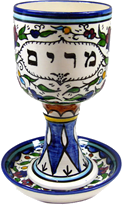
Filling Miriam’s Cup follows the second cup of wine, before washing the hands.
Raise the empty goblet and say: Miriam’s cup is filled with water, rather than wine. I invite women of all generations at our Seder table to fill Miriam’s cup with water from their own glasses.
Pass Miriam’s cup around the table(s); explain the significance of filling Miriam’s cup with water:
A Midrash teaches us that a miraculous well accompanied the Hebrews throughout their journey in the desert, given by God because of the merit of Miriam, the prophetess. Miriam’s optimism and faith also was a spiritual oasis, giving the Hebrews the confidence to overcome the hardships of the Exodus.
Like Miriam, Jewish women in all generations have been essential for the continuity of our people. As keepers of traditions in the home, women passed down songs and stories, rituals and recipes, from mother to daughter, from generation to generation. Let us each fill the cup of Miriam with water from our own glasses, so that our daughters may continue to draw from the strength and wisdom of our heritage.
When Miriam’s cup is filled, raise the goblet and say (from Rabbi Susan Schnur):
Yehi ratzon milfanecha, adonai eloheinu, velohei avoteinu, borei ha’olam: shetishm’reinu ut’kaymeinu bamidbar chayeinu im mayim chayim. V’titen lanu et hachizzuk v’et hachomchah l’daat she’tzmichat geulateinu nimtza baderekh chayim lo rak b’sof haderekh.
“You abound in blessings, God, creator of the universe, Who sustains us with living water. May we, like the children of Israel leaving Egypt, be guarded and nurtured and kept alive in the wilderness, and may You give us wisdom to understand that the journey itself holds the promise of redemption. AMEN.”
Next, tell the story of a Jewish woman you admire. Begin by saying:
Each Passover, we dedicate Miriam’s cup to a Jewish woman who has made important contributions in achieving equality and freedom for others. This year, we honor. . . (see “Honorees“).
After the rituals for the prophet Elijah, lift Miriam’s cup and say:
Miriam’s life is a contrast to the life of Elijah. Elijah was a hermit, who spent part of his life alone in the desert. He was a visionary and prophet, often very critical of the Jewish people, and focused on the world to come. On the other hand, Miriam lived among her people in the desert, constantly encouraging them throughout their long journey. Therefore, Elijah’s cup is a symbol of future messianic redemption, while Miriam’s cup is a symbol of hope and renewal in the present life. We must achieve balance in our own lives, not only preparing our souls for redemption, but rejuvenating our souls in the present. Thus, we need both Elijah’s cup and Miriam’s cup at our Seder table.
